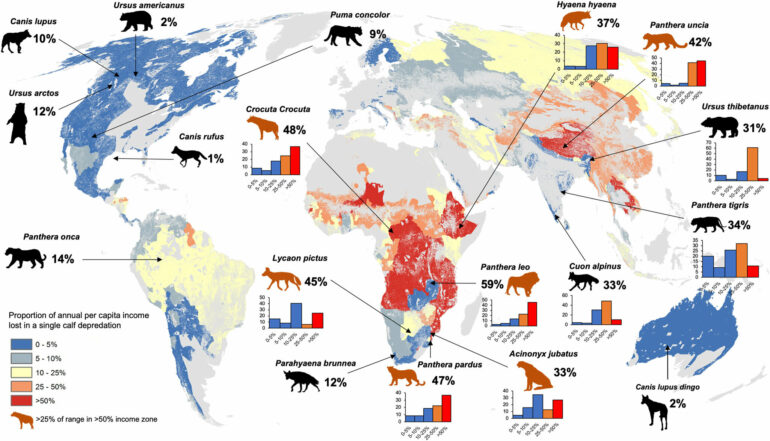A team of researchers has highlighted human-wildlife conflict as one of the globe’s most pressing human development and conservation dilemmas.
New research published in Communications Biology looked at 133 countries where 18 large carnivores ranged, and found that a person farming with cattle in developing countries such as Kenya, Uganda or India were up to eight times more economically vulnerable than those living in developed economies such as Sweden, Norway or the U.S.
Duan Biggs from Northern Arizona University’s School of Earth and Sustainability is the senior author of the study. He partnered with organizations throughout the world to conduct the research, hoping to find how the lives of those living alongside these large animals are impacted.
“For most farmers, livestock represents a key—if not their only—income source. When that livestock is threatened by large predators, it can be financially devastating for them,” Biggs said.
Alex Braczkowski, a research fellow at Griffith University in Australia and lead author of the study, confirmed that such farmers bear the biggest economic and household brunt.
“Our results mirror a lot of the conversations currently taking place in the climate change space; namely that developing economies from the Global South pay the biggest price for conservation, but in this case rather than protecting forests and providing an offset environment for big polluters, they are often the ones paying the price for living alongside species like African lions or tigers—species most of the world loves and wants to see being conserved.”
The study also found that the issue was exacerbated further in developing economies because cattle keepers in these areas produced 31% less cattle meat per animal on average than in developed economies.
In the lowest-income areas, results suggested that the loss of a single cow or bull equated to nearly 18 months of lost calories consumed by a child.
“Our research demonstrates the urgency of developing mechanisms like payments from wealthy urban areas in rich countries where people want predators like lions conserved, to the rural communities in the Global South that bear the costs and risks of living with these fierce and dangerous animals,” Biggs said.
The results also revealed that 82% of the carnivore range fell outside of protected areas, and five threatened carnivores have more than one-third of their range located in the most economically sensitive conflict areas.
The research team believes the findings highlight an unequal burden of human-carnivore conflict while grappling with multiple and conflicting sustainable development goals: protecting life on land and eliminating poverty and hunger.
“Our work helps show that to become truly nature positive, we need to consider both the benefits and the costs of wildlife to people, and ensure that those bearing the costs of living with wildlife are better supported, financially and otherwise,” said co-author Sophie Gilbert, senior lead for Natural Capital Development and co-author of the study. “Only when living with wildlife is stable and viable for local people will the conservation of creatures like large carnivores succeed.”
More information:
Alex Braczkowski et al, The unequal burden of human-wildlife conflict, Communications Biology (2023).
Provided by
Northern Arizona University
Citation:
Developing countries pay the highest price for living with large carnivores, finds study (2023, February 24)



